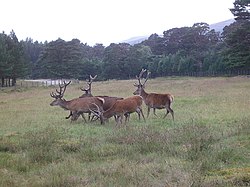Inverey
| Inverey Gaelic: Inbhir Eidh | |
| Aberdeenshire | |
|---|---|

| |
| Location | |
| Grid reference: | NO086891 |
| Location: | 56°59’3"N, 3°30’19"W |
| Data | |
| Postcode: | AB35 |
| Local Government | |
| Council: | Aberdeenshire |
Inverey is a hamlet on Mar Lodge Estate, in Aberdeenshire, west of Braemar. It straddles the Ey Burn close to its confluence with the River Dee whose course is just to the north of Inverey.
Inverey comprises two communities separated by the Ey Burn; Muckle Inverey on the east bank and Little Inverey on the west.
This village is a frequent starting point for vigorous walkers and Munro-baggers seeking to climb in the Grampian Mountains. The magnificent Beinn a' Ghlò rises to the south of the village, and to the west upstream on the River Dee is a famed waterfall, the Linn of Dee.
John Farquharson of Inverey

John Farquharson of Inverey was a rebel commander during the Jacobite rising led by John Graham of Claverhouse ('Bonnie Dundee') after James VII was deposed in 1688. Farquharson was commissioned as Colonel by John Graham. Due to his swarthy complexion, John Farquharson is usually referred to as the Black Colonel, and he participated in this rising, and after preventing a Government force of 100 men from occupying Braemar Castle he burnt it preventing its use by Government troops.
The final clash of the rising came on 17 July 1689 at the battle of Killiecrankie - where John Graham was killed. After this battle John Farquharson returned to the Braemar area - frequently staying at his home in Inverey Castle. During at least one visit by the 'red-coats' led him to hide-out in Glen Ey (pronounced like eye) on the shelf of rock still known as The Colonel's Bed. The 'red-coats' made do with plundering and burning the castle - the Black Colonel's loyal retainers ensuring he died of old-age about 1698, and was buried in Inverey.
The ruins of the old castle are still visible a short distance to the north of the road through Inverey, and the old burial-ground a short distance to the north-west of it.
In 1798 Inverey was added to Mar Estate by James Duff, 2nd Earl Fife.
Pictures
| ("Wikimedia Commons" has material about Inverey) |
-
Meall Darroch
-
Memorial to John Lamont
-
Inverey
-
Victoria Bridge, Inverey




